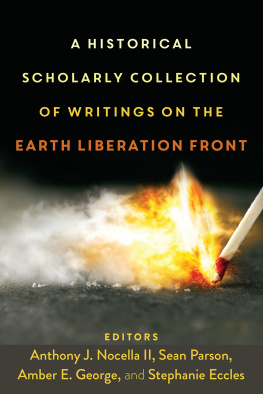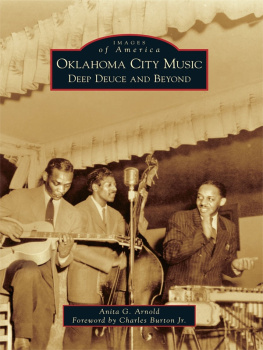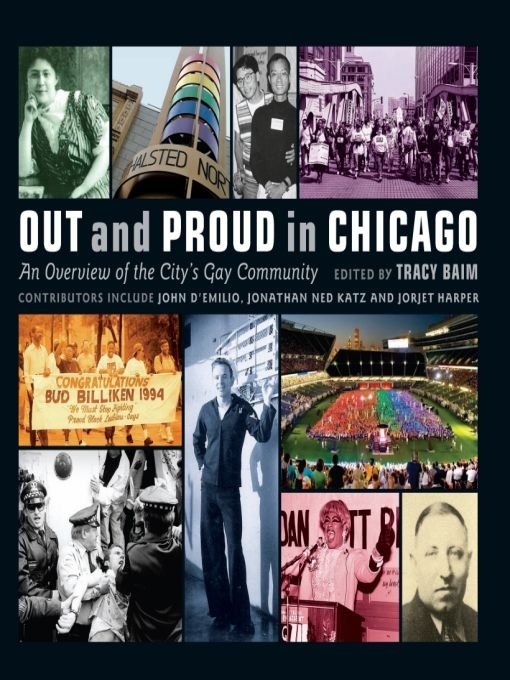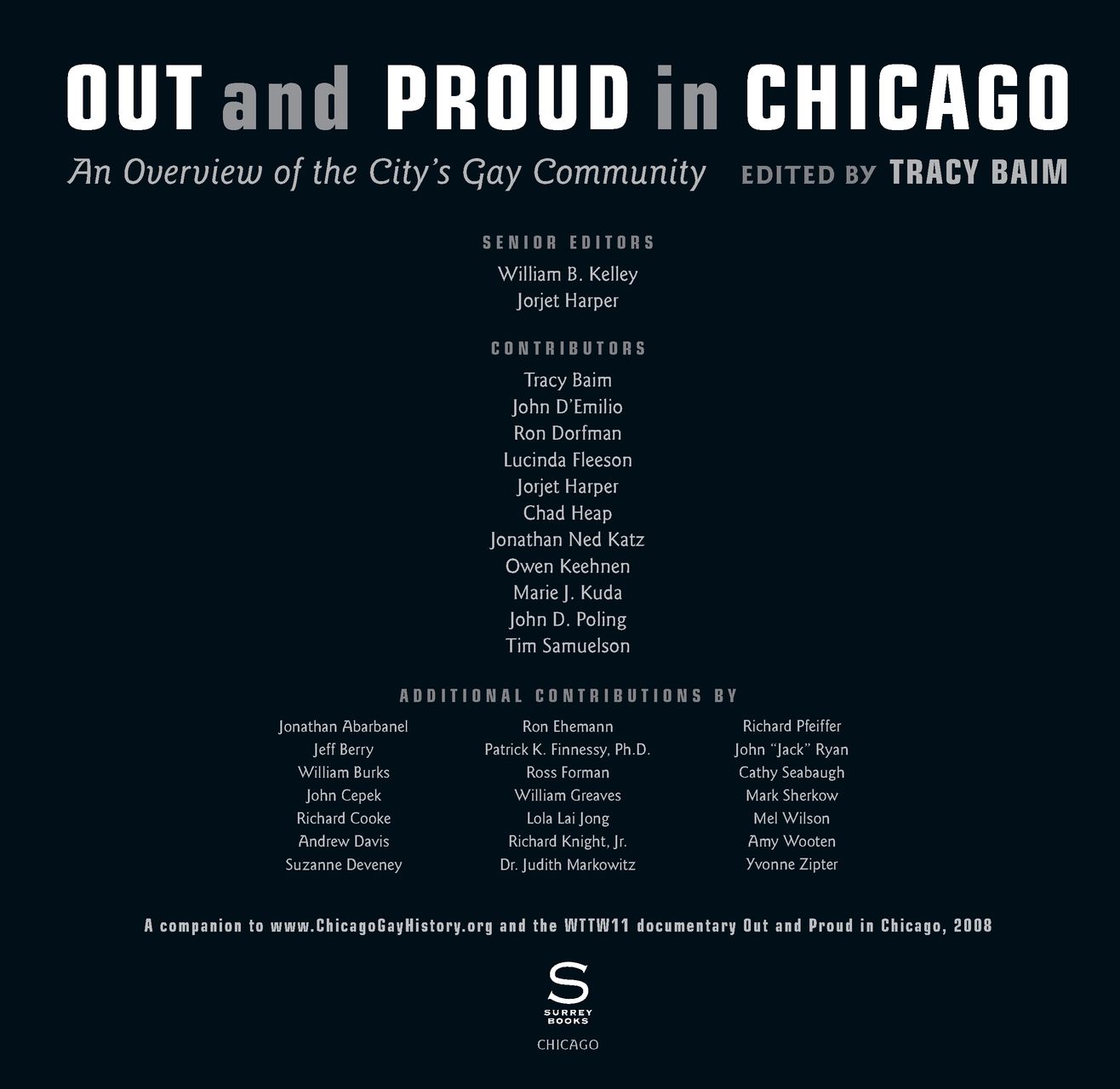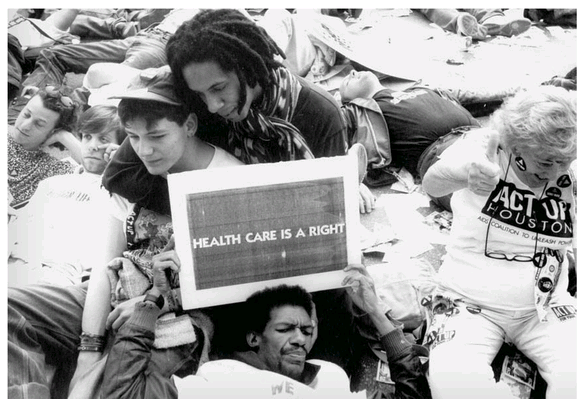Table of Contents
Nothing could be worse than the fear that one had given up too soon, and left one unexpended effort that might have saved the world.- JANE ADDAMS
THIS BOOK IS DEDICATED TO
Marie J. Kuda, Jean Albright, Renee Hanover, Toni Armstrong Jr., Jorjet Harper, Kathy Munzer, William B. Kelley, Michael Leppen, and Chuck Renslow
And to all the pioneers whose lives have been lost to AIDS, cancer, violence, suicide, accidentsand time.
There is a way to look at the past. Dont hide from it. It will not catch youif you dont repeat it.- PEARL BAILEY
THANK YOU There is a word, crabbing, that refers to the tendency of crabs to pull each other down in a tank rather than work together to find a way out. We are often too busy fighting one another, instead of the larger enemies in society. Despite the infighting, however, Chicagos gay community has accomplished much in a short window of time. In 2007, I wanted to begin the process of a deeper documentation of our communitymore than the weekly newspaper work I have done for nearly a quarter of a century. I was assisted in this by dozens of supporters. Wendy Jo Carlton and her team shot video as I interviewed more than 250 people on camera. Marie J. Kuda allowed me to scan hundreds of her documents. Lola Lai Jong, Robb Olsen, Diane Mareci and others transcribed interviews. My dad, Hal Baim, took photos of the subjects. Dozens of others assisted in some way.
And then, in February 2008, WTTW-Channel 11, which had been working on a gay documentary, approached Agate Publishing about doing a book as a companion volume to the video. I had been volunteering with WTTW to provide ideas for the film, and WTTW realized it could not pull together a book in six weeks. In the tradition of Life Cereals Lets get Mikey to eat it commercial, WTTW suggested I could tackle this. We had six weeks to produce a 224-page history of gay Chicago. Could what normally would take five or more years be done in six weeks? Only with a solid team, and only if existing scholarship could be used.
Almost every person who was asked to assist did so, including mainstream institutions. Chicago History Museum (Russell Lewis, Rob Medina and Debbie Vaughan), The University of Chicago Library Special Collections Research Center, The Newberry Library and others provided materials. Jonathan Ned Katz, John Poling, Chad Heap and Lucinda Fleeson (for her Chicago magazine piece) allowed reprints of their work. Kuda, John DEmilio, Tim Samuelson, Ron Dorfman, Jorjet Harper, Judith Markowitz, William Burks and Owen Keehnen wrote new pieces. Dozens of other writers joined me in writing the rest of the book.
William B. Kelley and Jorjet Harper have been amazing senior editors. Additional editing was provided by Kelli Martin and Perrin Davis.
Photographers were also generous. We have included many images from the newspapers I have published, Windy City Times and Outlines, but other media, including Gay Chicago and GayLife, also donated photos. Rich Pfeiffer of PrideChicago donated photos and newspapers, as did Nancy J. Katz, Otis Richardson and Caryn Berman, among others. The Leather Archives & Museum donated posters, and dozens of individual photographers, including Lisa Howe-Ebright and Genyphyr Novak, offered their work for use. The Chicago Gay and Lesbian Hall of Fame and William Greaves shared materials. We had many people scanning old photos and newspapers, including Mary Schultz, Jean Albright, Vern Hester and Brad Kohnert. The Web site is being created by Materville Studios. Jerry Glover provided legal support. Kirk Williamson assisted on graphics. The Windy City Media Group staff helped in various ways.
Since I started work in gay media in 1984, I have met many mentors in the community who made me strive for excellence. This short six-week journey to a book was informed by 24 years of working with amazing people. Some are mentioned here, but there are hundreds more. Thank you to Nan Schaffer, the late Mary York, Fred Eychaner, Modesto Tico Valle, Mona Noriega, Evette Cardona, Dick Uyvari and Joe La Pat, and those listed above. To my friends and family (Jean, Marcy, Anthony, Clark, Eden, Hal, Kathy, Kelli, Deb, Diane, and more), who have been patient as I keep committing to major projects: You all make the impossible possible. And last, to my late parentsmy mother, Joy Darrow, and stepfather, Steve Prattthank you for allowing me to dream.
The approach of this book is obviously more journalistic than academic. Many books could be written about the Chicago gay movement, and I hope to write more in the future. Out and Proud serves as an overview, especially focused on the years pre-1980, so I thank the community in advance for not crabbing about this book. Not everyone could be included, but the www.ChicagoGayHistory.org Web site will feature thousands of people, starting in June 2008. Enjoyand be inspired to write down your own histories. Tracy Baim
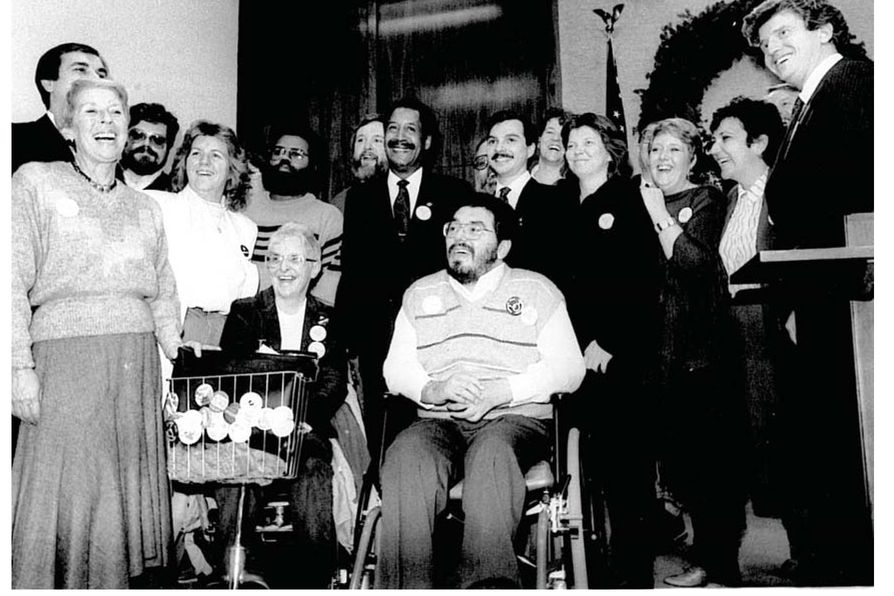
Activists celebrate with Mayor Eugene Sawyer after the passage of gay-inclusive human rights legislation in the Chicago City Council in 1988. See pages 166-167. From left: Vince Samar, Charlotte Newfeld, Steve Jones, Linda Henderson, Chris Cothran, Bill Williams, Mayor Sawyer, Vern Huls, Rick Garcia, Rick Dean, Laurie Dittman, Jon-Henri Damski (hidden), Kit Duffy, an unidentified woman, Art Johnston (partially hidden) and Jon Simmons. Front: Phyllis Doering and Rene Luna. Courtesy Outlines/Windy City Times archives.
At a late-1980s ACT UP die-in in downtown Chicago. Front is Ortez Alderson, a prominent AIDS activist who helped organize a major People of Color AIDS Conference. He died in 1990 from AIDS complications. See pages 148-157. Photo by Lisa Howe-Ebright.
INTRODUCTION
by TRACY BAIM
IF AN ACTIVIST STANDS ON THE CORNER WITH A SIGN AND NOBODY TAKES A picture, did it really happen?
The tree falls in the forest metaphor may not be a perfect fit, but the work of thousands of gay activists has been lost to history because it was never documented. As generations of our community die, our history dies with them.
A few brave people did try to document our community, either as major events were happening or through groundbreaking historical research. These writers, journalists, photographers, filmmakers, academics and historians have tried to find many needles in the haystack, through interviews with pioneers, digging into old university and museum archives, and reading the often-biased coverage of the mainstream media. In some cases, finding out if there was a there there meant reading between the lines and piecing together what it was to be gay 100 years ago, when letters and photos may have been destroyed. People usually did not come out in any political sense, and families tried to hide any trace of immoral behavior once their famous relatives passed on.
Unfortunately, this still happens today. I began covering the Chicago gay community in 1984, just as AIDS was starting its devastation. As people died, their families often shunned partners and friends and threw away archival materials. This happened time and again, as older gays died in nursing homes, lesbians died of cancer and many young activists were struck down in their prime by violence, accidents or suicide. A few managed to leave a lasting, documented legacy, foremost among them Greg Sprague, who started a history project in the 1970s and was a force behind the founding of our citys main gay and lesbian library and archives. His materials are now stored at the Chicago History Museum.



